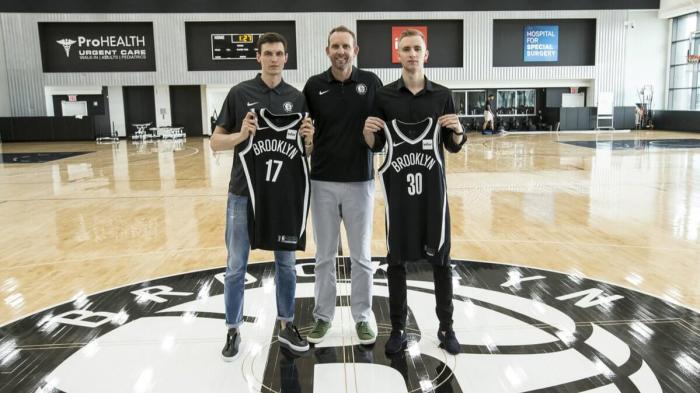 Jesse D. Garrabrant/Getty Images
Jesse D. Garrabrant/Getty Images
No matter when the NBA season starts, chances are it’ll either run late (possible) or won’t be 82 games long. Stuffing 82 games into a season sans one month is a recipe for disaster. Even when the league does return (which, apparently, could be today), smart folks are floating ideas about overhauling the NBA schedule.
Hey, as long as we’re shortening the season, might as well do it right.
Kevin Arnovitz is one of those smart folks. Kevin recently proposed a 44-game NBA season, wherein you play each opponent once (29 games), each conference opponent one additional time (14) and one more game against your seeding equal in the opposing conference (so #1 seed Chicago would face #1 seed San Antonio twice, #2 Miami would face #2 Los Angeles, and so on). I like many of the ideas in Kevin’s proposal (and as you’ll see later, I incorporate them in my own). I like the idea of a shortened season — 82 games for any team can be too long, and by the end of covering last season’s Nets, it was the blogging equivalent of drowning. But I do take issue with Kevin’s 44-game proposal, for two reasons.
Firstly, a successful schedule enhances the division rivalry. A 44-game season lends more weight to the conference game, but not the division game. Proximity and division standings matter to fans, and highlighting what matters to fans improves revenue. You want to see your biggest rivals on the court as much as possible; a Mavericks-Spurs game is more important than a Mavericks-Jazz game. The average fan is more likely to tune into a Nets-Knicks or Nets-Celtics game than Nets-Magic, even though the Magic may be a better team. It makes sense for the NBA to maximize these matchups.
The attendance numbers bear that out. Last season, the average in-division game drew over 400 (439, to be exact) more fans per game than a non-divisional contest, with some teams seeing over 1,000. With 240 divisional games per season, that’s 105,000 extra fans in the arena, buying overpriced nachos, beer, and t-shirts for owners and players to split somehow in that magical pot of BRI.
Secondly, and more simply, I think it’s not enough basketball for too much time. I believe NBA players can handle more than two games per week and play at their physical peak. I like watching basketball more than 44 times per season, whether it’s Deron Williams or Johan Petro. The randomness might add excitement, but more basketball adds excitement too.
So, in the interest of bugging you with my ideas, here’s my thoughts.
72 games
As I said earlier, I think the NBA needs to shorten from 82 games, not just for this season (when it’s a time necessity) but beyond. Instead of a cut from 82 to 44, I propose a more minor cut – ten fewer regular games over 25 weeks, totaling 72. That adds up to three games per week on a set schedule (more on that in a bit), with one week off for the All-Star break.
While the extra ten games off per year may mess with some milestone chases — Kobe Bryant, for instance, is about 10,000 points away from Kareem Abdul-Jabbar’s all-time scoring record — the mileage saved on player bodies potentially lengthens their careers, without too much of a cut back from 82.
Splitting the schedule
Each club would play one home/away split against the other 29 teams (58 games), an additional home-away split against each team in their division (8 games), one extra game against their equals in each division (5 games), and one other randomly chosen game (ideally against a conference opponent) to make it an even 72. By “equals in each division,” I mean that the #1 team in the Pacific Division the previous season would play an extra game against the #1 team in the Atlantic, Central, Southeast, Northwest and Southwest Divisions, the #2 team would play the #2 teams in the other five divisions, and so on. Unfortunately, this could lead to a “Cleveland” situation, where a team loses its best star and plummets the next season, only to face five still-excellent teams the next season. I’m willing to see that changed for predictive measures, though it could prove difficult to forecast.
One argument against that formula is the five-game divisional split alters competitive balance; the top teams beating up on one another makes for an increasingly difficult schedule for the best teams, and an easier one for the worst. An alternate way to split those five games is to have each division rotate between playing #1-#5 in alternate divisions. Here’s what I mean: in 2011-12, Boston (#1 in the Atlantic Division last year) would play an extra contest against the #1 team in the Central, #2 in the Southeast, #3 in the Northwest, #4 in the Pacific, and #5 in the Southwest. In 2012-13, the #1 team in the Atlantic Division from 2011-12 would play the #1 team in the Southeast, #2 in the Northwest, #3 in the Pacific, #4 in the Southwest, and #5 in the Central, and so on, repeating every five years. This makes for less marquee games, but for a more balanced overall schedule.
When do they play?
I like Kevin’s idea of a set schedule each week over a 23-week season, so I’m going to tinker it a bit with it to fit my 72/25 formula. Instead of a Tuesday/Thursday doubleheader with 22 games on Wednesday and a weekend game, I propose a weekly schedule of Tuesday/Thursday/Saturday and Wednesday/Friday/Sunday, with minor exceptions for holidays (for instance: if Christmas falls on a Monday, the league can take Sunday off and play Christmas night games Monday, and those teams play the Wednesday schedule the week afterward. It needs some adjusting, but it would work). Major games would normally be scheduled for Thursday, Friday, and Saturday nights. Teams would ideally alternate between each schedule weekly, playing Tuesday/Thursday/Saturday one week, then Wednesday/Friday/Sunday the next.
Three games per week, plus one week off for the All-Star break, over 25 weeks between November and mid-April = 72 games. This eliminates back-to-backs, minimizes the effect of randomness on the season outcome (though it still exists), and capitalizes on the league’s most profitable games — division rivalries and the top teams from each division. If it’s too late to salvage 25 weeks this year, the league can easily go to a 66-game format over 23 weeks, losing the inter-divisional games and random opponent for one season for the sake of transition.
I’m with Kevin on one thing; 82 games is arbitrary, and doesn’t seem right. Leaving the season at 82 because “that’s what we’ve always done” doesn’t seem like particularly good logic. A 72-game season isn’t perfect, though I’m not sure perfection is the goal here. That said, if there’s a way to increase viewer interest and individual game importance without seriously compromising (and potentially increasing) the revenue stream, the NBA must give it some thought, and a 72-game season hits all three of those targets.



















